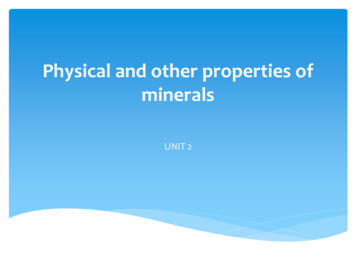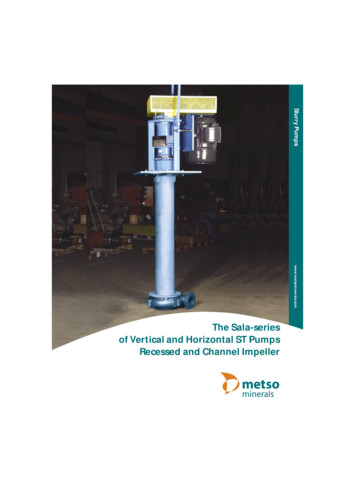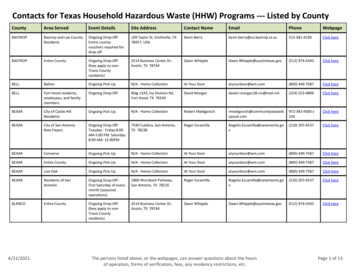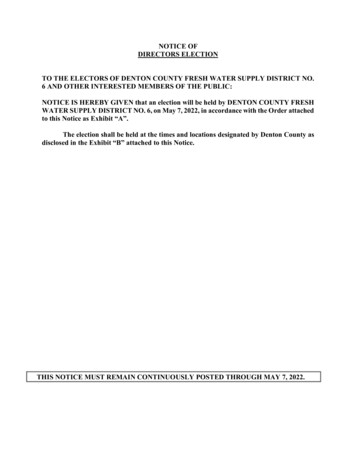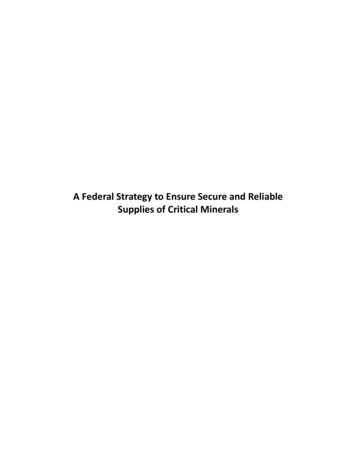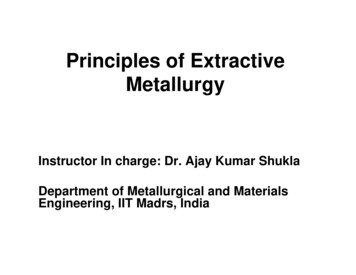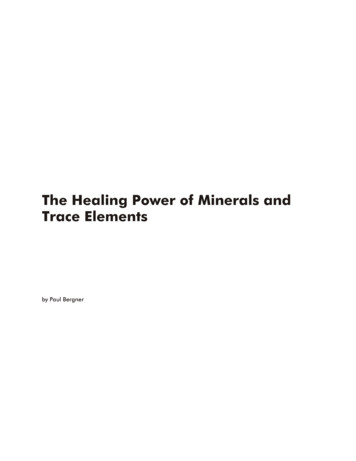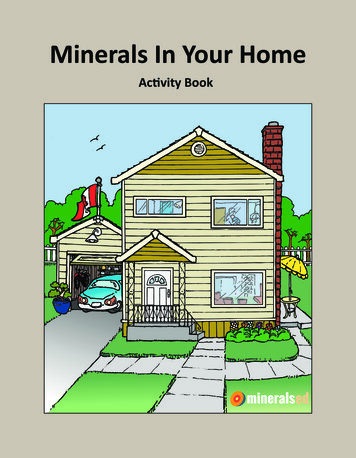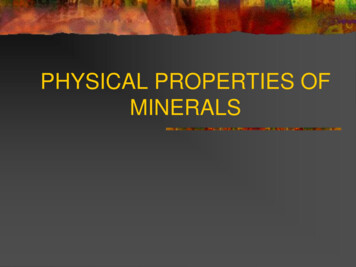
Transcription
PHYSICAL PROPERTIES OFMINERALS
Mineral Identification Basics What is a Mineral?There is a classic definition formineral.Minerals must be:InorganicOccurs Naturally on EarthAlways a SolidHas Definite Chemical CompositionCrystalline StructureCubic Fluorite Crystal
Mineral Identification Basics What is a Mineral?Naturally OccurringMinerals are not syntheticor man made - they areproduced by the naturalgeological processes workingon Earth.Tourmaline Crystal from Brazil
Mineral Identification Basics What is a Mineral?InorganicBarite Rose - A flower like growthof Barite crystals.Minerals are NOTproduced by organic livingprocesses. As a result thingslike pearls, coral, coal andamber are NOT consideredminerals.
Mineral Identification Basics What is a Mineral?Crystalline StructureMinerals are the result ofatoms joining togetherthrough electrical bonds toproduce a definite internalstructure.Crystalline Pattern of HaliteHalite (salt) from Searles Lake, CARed SodiumGreen Chlorine(*)
Mineral Identification Basics What is a Mineral?Definite Chemical CompositionHalite - NaClFor every atom of Sodium there isan atom of Chlorine.Minerals can be expressed bya chemical formula. Theinternal order of minerals meansthat there is a definiterelationship in the number ofatoms that makes up the mineral.
Mineral Identification Basics PHYSICAL PROPERTIES HARDNESSHARDNESS is defined as theresistance a mineral has to beingscratched - its “scratchability”.Hardness tests are done by scratchingone mineral against another. Themineral that is scratched is softer thanthe other.Pyrite CrystalsHardness of 6.5
Mineral Identification Basics PHYSICAL PROPERTIES HARDNESSIn this photo, a quartz crystalwill be rubbed across a glassplate. The result is that the glassplate will be scratched. Thequartz is therefore harder thanthe glass.Quartz is harder than glass.
Mineral Identification Basics PHYSICAL PROPERTIES HARDNESSCare must be taken on some minerals thatcrumble easily. Remember that hardness isthe resistance a mineral has to beingscratched - NOT how easily it breaks apart.
Mineral Identification Basics PHYSICAL PROPERTIES HARDNESSMOH’S SCALE OF MINERAL HARDNESS1. TALC6. FELDSPAR2. GYPSUM7. QUARTZ3. CALCITE4. FLUORITE5. APATITE8. TOPAZ9. CORUNDUM10. DIAMONDOTHER MATERIALS COMMONLY USED:Moh’s scale is a list of minerals with increasing hardness.(*)2.5 - FINGERNAIL3 - COPPER PENNY5.5 - GLASS6-6.5 - STEEL FILE
Mineral Identification Basics PHYSICAL PROPERTIES CLEAVAGECLEAVAGE is the property of amineral that allows it to breakrepeatedly along smooth, flatsurfaces.These GALENA cleavage fragmentswere produced when the crystal washit with a hammer. Note theconsistency of the 90o angles along theedges.These are FLUORITE cleavagefragments.
Mineral Identification Basics PHYSICAL PROPERTIES CLEAVAGEWithin this crystalline pattern it iseasy to see how atoms willseparate to produce cleavage withcubic (90o) angles. (*)It is similar to tearing a piece ofpaper that has perforations in it.The paper has a tendency to tearalong the perforations. They arezones of weakness. (*)In this example the lines represent breaks between the atoms that make up themineral. Cleavage is guided by the atomic structure. (*)
Mineral Identification Basics PHYSICAL PROPERTIES CLEAVAGEThese pictures show different cleavage angles and the quality of cleavage.Fluorite has cleavage in fourdirections. (*)MicaA thinhassheetperfectof Muscovitecleavage inseenONEondirection.edge. (*)
Mineral Identification Basics PHYSICAL PROPERTIES CLEAVAGECommon salt (the mineral HALITE) has very good cleavage in 3 directions. (*)These 3 directions of cleavage aremutually perpendicular resulting incubic cleavage. (*)
Mineral Identification Basics PHYSICAL PROPERTIES CLEAVAGERhombohedralCleavage - 3 directionsCALCITEEven these tiny fragments have rhombohedral cleavage. (*)(*)
Mineral Identification Basics PHYSICAL PROPERTIES FRACTUREFRACTURE is defined as the way amineral breaks other than cleavage. (*)This is a piece of volcanic glass calledOBSIDIAN. Even though it is NOT amineral, it is shown here because it hasexcellent conchoidal fracture. (*)If you try this yourself, use caution.Conchoidal fracture in obsidian canproduce extremely sharp edges. (*)
Mineral Identification Basics PHYSICAL PROPERTIES FRACTUREThis Quartz crystal will bestruck with a hammer toshow how that the externalform of the crystal does notrepeat when broken. (Theflat crystal faces are notcleavage faces.)This is a good example ofconchoidal fracture. (*)Note the smoothcurved surfaces. (*)
Mineral Identification Basics PHYSICAL PROPERTIES STREAKSTREAK is defined as thecolor of the mineral in powderform. (*)Streak is normally obtained by rubbing amineral across a “streak plate”. This is apiece of unglazed porcelain. The streak platehas a hardness of around 7 and rough texturethat allows the minerals to be abraded to apowder. This powder is the streak. (*)Hematite on Streak PlateHematite has a reddish brown streak. (*)
Mineral Identification Basics PHYSICAL PROPERTIES STREAKSphalerite is a dark mineral,however, it has a light coloredstreak. Next to the reddish brownstreak of hematite is a light yellowstreak. This is the streak of thesphalerite. (*)Light colored streaks are oftendifficult to see against the whitestreak plate. It is often useful to rubyour finger across the powder to seethe streak color. (*)Sphalerite has a light yellow streak. (*)
Mineral Identification Basics PHYSICAL PROPERTIES LUSTERLUSTER is defined as the qualityof reflected light. Minerals havebeen grossly separated into eitherMETALLIC or NON-METALLIClusters.Following are some examples:Native Silver has a Metallic Luster.(*)
Mineral Identification Basics PHYSICAL PROPERTIES LUSTER METALLICStibniteGalenaThe basic idea for Metallic Luster is that the minerals look like metals. (*)Pyrite (*)Marcasite
Mineral Identification Basics NON-METALLIC LUSTER VITREOUSVitreous Luster means that the mineral has a “glassy” look.Normally we think of glass as being clear, but there are manydifferent colors of glass and they are all very “glassy” looking. Evenchina plates and glazed porcelain are vitreous. Here are someexamples: (*)Olivine - PeridotSpinelWulfeniteQuartz (*)
Mineral Identification Basics NON METALLIC LUSTERMiscellaneous LustersAsbestos - SilkyApophyllite – Pearly (*)Graphite has a greasy or submetallic lusterand easily marks paper. (*)Limonite - Dull or EarthySphalerite - Resinous
Mineral Identification Basics PHYSICAL PROPERTIES COLORThe COLOR of a mineral is usuallythe first thing that a person noticeswhen observing a mineral. However, itis normally NOT the best physicalproperty to begin the mineralidentification process. (*)Following are some examples of colorvariation within mineral speciesfollowed by minerals that have adistinctive color: (*)Various colors of CALCITE. (*)
Mineral Identification Basics PHYSICAL PROPERTIES COLORAmethystQuartz comes in a wide range of colors. It is very easily coloredby even trace amounts of impurities. (*)Ionic IronClear - Without ImpuritiesHematite InclusionsVarious colors of Quartz.Chlorite inclusions
Mineral Identification Basics INDICATIVE COLORSome minerals do have a certaincolor associated with them. Here aresome examples: (*)TurquoiseMalachiteRhodochrositeAzurite (*)Sulfur
Mineral Identification Basics PHYSICAL PROPERTIES SPECIFIC GRAVITYThe SPECIFIC GRAVITYof a mineral is a measureof the mineral’s density. Itis related to the types ofelements that make up themineral and how they arepacked into the mineral’satomic structure.Gold in Quartz
Mineral Identification Basics PHYSICAL PROPERTIES TASTEIT IS NOT RECOMMENDEDTHAT A TASTE TEST BEPERFORMED ON MINERALSAS A STANDARD PROCESS.SOME MINERALS ARE TOXIC.However, the mineral HALITE is commonsalt and has a unique taste. (*)Halite cubes from Trona, CA (*)
Mineral Identification Basics PHYSICAL PROPERTIES MAGNETISMMAGNETISM is the ability ofa mineral to be attracted by amagnet. This most commonlyis associated with minerals richin iron, usually magnetite.This is a piece of MAGNETITE with a magnetadhering to it. Magnetite is a mineral that isstrongly magnetic in that a magnet will easily beattracted to it. (*)
Mineral Identification Basics PHYSICAL PROPERTIES MAGNETISMThis is a sample of “black sand”from Lynx Creek, Arizona. Its darkcolor is due to its highconcentration of magnetite. Seewhat happens when a magnet isplace beneath the bottom rightportion of the paper. (*)This technique is used to separate out much of the unwanted material in the searchfor gold in placer deposits. (*)
Mineral Identification Basics PHYSICAL PROPERTIES MAGNETISMLODESTONE is a varietyof Magnetite that isnaturally a magnet. (*)
Mineral Identification Basics DOUBLE REFRACTIONDOUBLEREFRACTION: Is aproperty shared by manyminerals ( but not thosein the isometric crystalsystem). It is producedby the separating of abeam of light as it passesthrough the crystalstructure. It is bestdisplayed in the mineralCALCITE. This imageclearly shows the doubleimage below the calcite.
Mineral Identification Basics CHEMICAL PROPERTIESREACTION TO ACIDSome minerals, notably thecarbonates, react to colddilute HCl. In thisillustration a piece ofCALCITE is shown toreact (fizz) after HCl isapplied.Calcite Reacts to HCl (*)
This ends the basic introduction tothe Physical Properties of Minerals.
Mineral Identification Basics PHYSICAL PROPERTIES CLEAVAGE Within this crystalline pattern it is easy to see how atoms will separate to produce cleavage with cubic (90o) angles. (*) It is similar to tearing a piece of paper that has perforations in it. The paper has a tendency to tear along the perforations. They are zones of weakness.
